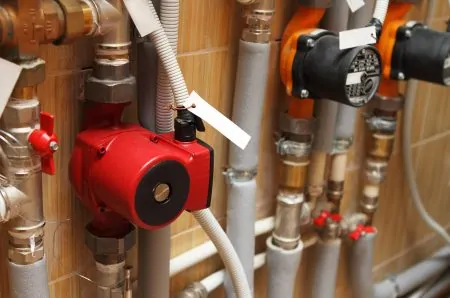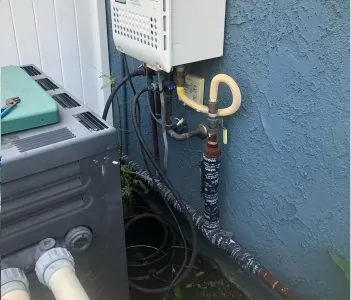Before starting your annual maintenance, you need to know how to turn off your water heater safely. Whether it’s a gas or electric model, shutting it down is crucial when you want to drain the tank, make repairs, or have a water leak.
We show you how to turn off a hot water heater and offer you pro tips to reduce your energy costs.
Key Takeaways
- Locate the shut-off valve on your water heater and turn it off to stop the water supply.
- For gas heaters, turn the temperature dial to off and shut off the gas supply.
- For electric heaters, cut the power using the breaker board and drain the tank.
- Reduce energy costs by adjusting temperature, taking shorter showers, and using a timer or insulation blanket.
Is It Okay to Turn Off a Water Heater?
It is okay to turn off your water heater, especially if it is leaking or you smell gas. Even if you are going away for the weekend, you can safely cut the power supply when not in use. If you are going on vacation for longer than a couple of days, always drain the tank.
Stagnant water breeds bacteria that cause E.coli infection, cholera, botulism, and many other nasty surprises. Draining the tank keeps it clean and flushes the system, ready to be refilled.
There’s also the practical side because a full tank left unattended could leak. Given that water tanks hold between 40 and 60 liters on average, that’s a lot of potential water damage.
Where Is the Water Heater Shut Off Valve?
You will find the shut-off valve on the inlet pipe at the top of the tank. Failing that, if you don’t have an isolating valve, you will need to locate the main water supply valve and shut that off instead.
How to Turn Off a Water Heater
It makes sense to know how to shut off a water heater, especially in an emergency. But knowing what type of heater you have is also vital if you want to perform the shut down safely.
Electric heaters have AC power cables, and gas models have a wide vent at the top of the tank.
Safety Precaution
Never drain a water tank when the water is hot. Always wait while the tank cools before performing a drain-down.
On Gas Heaters
First, we will walk through the steps for shutting off a gas water heater. The process is simple enough but slightly different from electric models.
- Locate the temperature dial at the base of the tank. It is typically situated on the front panel, near the drain valve and pilot light switch.
- Turn the dial all the way to off.
- Switch the water valve off by either flicking the lever or turning the screw clockwise.
- Switch and unplug the water heater from the socket. Gas water heaters require electricity to spark the pilot light.
- Attach a hosepipe to the drain valve and open the valve. The water will flow out. Remember to have a bucket handy to catch the water.
- Locate the gas supply line, usually located on the right-hand side of the water heater. It will either be a lever or knob that you turn clockwise to shut off the gas supply.
- Locate the relief valve on the top of the tank and open it to allow air to fill the tank.
- That’s it. The tank is shut off and empty.
On Electric Water Heaters
Electric water heaters are far simpler to shut down because you don’t have to shut off a gas supply. Follow these steps to do it safely:
- Cut the power by flicking the switch on the breaker board.
- Locate the water supply. You will either find a valve on the inlet pipe at the top of the tank or locate the main water supply valve to the property.
- Now that the heater is non-operational, drain the tank.
- Attach a garden hose to the drain valve at the tank’s base. Ensure the hose reaches outside or a large bucket.
- Turn the drain valve counterclockwise, and the water will start to flow.
- Turn on a hot water faucet nearest the tank to relieve pressure on the system.
- And the tank is successfully isolated and drained.
Word Of Caution
When you turn the water back on, open the valve slowly because a sudden rush of water can shake something loose and cause leaks.
How to Turn Off the Water Heater Timer
You will either have a dial heater control or an electronic timer. The principle of operation is the same, but let’s look in detail at both.
Dial
Adjusting the water heater timer is simple enough. Turn the dial to the required time setting, but leave the arm that points at 90 degrees. Some timers have tiny pins that you depress for the time frame you want the heater working.
So, if you want the water hot for a bath at eight pm, depress the pins to start the boiler at about seven pm, and the water should be hot when you need it.
You will need to mark a designated shut-off time, or the boiler will continue to heat the water until the thermostat kicks in and shuts it off.
Electronic Timer
Set your heater clock to the correct time. Choose the select clock or time setting and set it to the time you want the heater to come on. You can adjust the timer settings using the up and down arrows to find the right day and time.
Finally, hit the set or run button to confirm your settings.
Tips for Reducing Water Heater Energy Costs
Water heaters account for about 17 percent of your energy bill, so finding handy ways to reduce your costs is always welcome. Well, today is your lucky day!
Reduce the Temperature
New water heaters typically have a preset temperature of 140 degrees Fahrenheit. Still, if you turn the temperature down to 120 degrees Fahrenheit, you reduce your energy usage by three to five percent.
Also, keeping a constant temperature is more cost-effective than rapidly heating the tank because you burn more gas and electricity.
Take Shorter Showers
By their very nature, showers are designed for hop-in-hop-out use. If you are luxuriating in a shower for hours, you are using the shower incorrectly and racking up significant energy bills.
Also, turn the shower temperature down, and if you can, switch off the water while you shampoo, lather up, or shave.
Fit a Water Heater Insulation Blanket
A straightforward solution is to keep the water in the tank hot for longer once it reaches temperature. The easiest way to do this is to insulate the tank’s exterior with a thermal blanket like this Energy Star Certified Non-Fiberglass Jacket.
Think of it as a winter coat to keep your water warm. They have an R-value of seven and reduce heat loss by 40 percent.
Top Tip
R-value is the measure of thermal resistance to heat flow. The higher the R rating, the more efficient the insulation.
Use Cold Water Where You Can
Don’t waste hot water for household chores; use cold instead. Save the hot water for the essential things like washing up and showers.
Repair Leaky Faucets
Faucets leak and waste precious hot water. Stay on top of maintenance and nip leaks in the bud before they escalate. It’s worth noting that the leak will only get worse, so don’t ignore it.
A small cost today could grow to an entire faucet replacement that costs bigger bucks.
Install a Timer
Installing a timer ensures that the water heater only comes on when you want it at designated times. It is an automatic way to control energy bills and reduce wasted resources.
Modern electrical water heaters have a timer installed, but consider sucking up the expense and fit a timer if you have an older model.
Swap Old for New
Sooner or later, your water heater will lose efficiency as it ages. Consider replacing it with a newer model, or even a tankless heater, like this Rheem RTEX-18 Tankless model. It allows a constant hot water supply and only heats the water you use on-demand.
It removes the need to heat 60 liters of water when you only need two to wash your hands. These systems are also beneficial in apartments where space is limited.
FAQs
Final Thoughts
Shutting off water heaters is necessary to perform maintenance and drain the tank from time to time. Knowing how to shut off a water heater is an essential skill that every homeowner should possess.
You never know when you need to perform an emergency shut-off, so being prepared is the priority.











